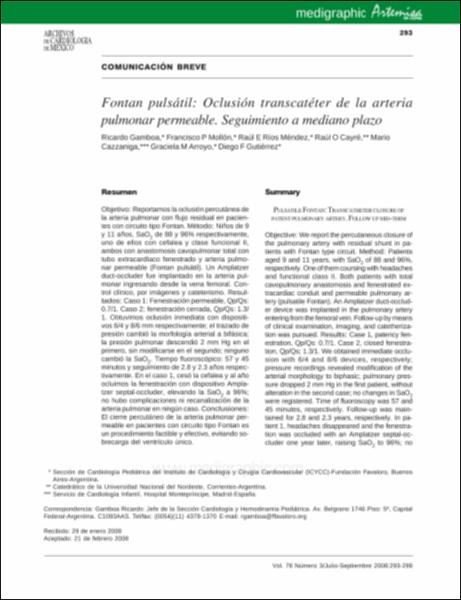Fontan pulsátil : oclusión transcatéter de la arteria pulmonary permeable. Seguimiento a mediano plazo
Fecha
2008Autor
Gamboa, Ricardo
Mollón, Francisco P.
Ríos Méndez, Raúl E.
Cayré, Raúl O.
Cazzaniga, Mario
Arroyo, Graciela M.
Gutiérrez, Diego F.
Metadatos
Mostrar el registro completo del ítemResumen
Objetivo: Reportamos la oclusión percutánea de la arteria pulmonar con flujo residual en pacientes con circuito tipo Fontan. Método: Niños de 9 y 11 años, SaO2 de 88 y 96% respectivamente, uno de ellos con cefalea y clase funcional II, ambos con anastomosis cavopulmonar total con tubo extracardíaco fenestrado y arteria pulmonar permeable (Fontan pulsátil). Un Amplatzer duct-occluder fue implantado en la arteria pulmonar ingresando desde la vena femoral. Control clínico, por imágenes y cateterismo. Resultados: Caso 1: Fenestración permeable, Qp/Qs: 0.7/1. Caso 2: fenestración cerrada, Qp/Qs: 1.3/1. Obtuvimos oclusión inmediata con dispositivos 6/4 y 8/6 mm respectivamente; el trazado de presión cambió la morfología arterial a bifásica; la presión pulmonar descendió 2 mm Hg en el primero, sin modificarse en el segundo; ninguno cambió la SaO2. Tiempo fluoroscópico: 57 y 45 minutos y seguimiento de 2.8 y 2.3 años respectivamente. En el caso 1, cesó la cefalea y al año ocluimos la fenestración con dispositivo Amplatzer septal-occluder, elevando la SaO2 a 96%; no hubo complicaciones ni recanalización de la arteria pulmonar en ningún caso. Conclusiones: El cierre percutáneo de la arteria pulmonar permeable en pacientes con circuito tipo Fontan es un procedimiento factible y efectivo, evitando sobrecarga del ventrículo único. Objective: We report the percutaneous closure of the pulmonary artery with residual shunt in patients with Fontan type circuit. Method: Patients aged 9 and 11 years, with SaO2 of 88 and 96%, respectively. One of them coursing with headaches and functional class II. Both patients with total cavopulmonary anastomosis and fenestrated extracardiac conduit and permeable pulmonary artery (pulsatile Fontan). An Amplatzer duct-occluder device was implanted in the pulmonary artery entering from the femoral vein. Follow-up by means of clinical examination, imaging, and catetherization was pursued. Results: Case 1, patency fenestration, Qp/Qs: 0.7/1. Case 2, closed fenestration, Qp/Qs; 1.3/1. We obtained immediate occlusion with 6/4 and 8/6 devices, respectively; pressure recordings revealed modification of the arterial morphology to biphasic; pulmonary pressure dropped 2 mm Hg in the first patient, without alteration in the second case; no changes in SaO2 were registered. Time of fluoroscopy was 57 and 45 minutes, respectively. Follow-up was maintained for 2.8 and 2.3 years, respectively. In patient 1, headaches disappeared and the fenestration was occluded with an Amplatzer septal-occluder one year later, raising SaO2 to 96%; no complications occurred nor was recanalization of the pulmonary artery needed in either case. Conclusions: Percutaneous occlusion of patent pulmonary artery in patients with Fontan type circuit is a feasible and effective procedure, and avoids overload of the single ventricle.
Colecciones
- Artículos de revista [166]





